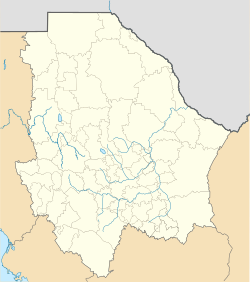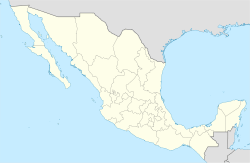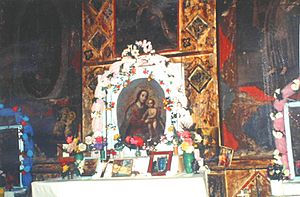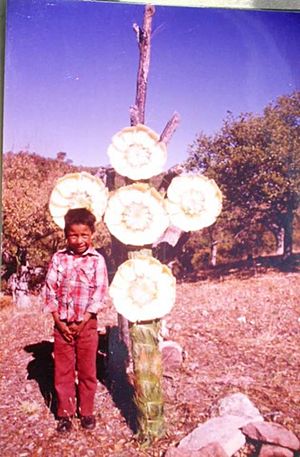Yepachic facts for kids
Quick facts for kids
Yepáchic
Yepáchi
|
|
|---|---|
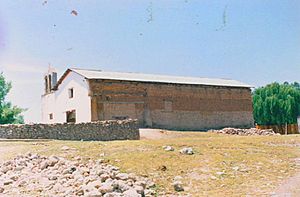
Spanish mission church in Yepáchic
|
|
| Country | |
| State | Chihuahua |
| Municipality | Temósachic |
| Elevation | 1,780 m (5,840 ft) |
| Population | |
| • Total | 851 |
Yepáchic, also known as Yepáchi, is a small town in western Chihuahua, Mexico. It is about 10 kilometers (6 miles) east of the border with the state of Sonora. The town is located in the Temósachic area and sits high up in the Sierra Madre Occidental mountains, about 1,780 meters (5,840 feet) above sea level.
Many people living in this area are part of an indigenous group called the Mountain Pima, or Pima Bajo. They are related to the Pima and Tohono O'odham tribes from Arizona and northern Sonora. They speak a language that is similar but still different from those tribes.
Most maps show the town's name as Yepáchic. However, the people who live there and the road signs nearby spell it Yepachi. In 2010, the official population was 851 people. But this number grows to a few thousand during holidays. This happens when people from smaller villages nearby come to Yepáchic to celebrate.
The weather in Yepáchic is one of the coolest in all of Mexico. It often snows here in the winter. Spring and fall are usually dry seasons. In late summer, there are many thunderstorms. The area is covered with mixed forests of pine and oak trees. The mountains are often very steep, and the soil can be loose, making travel difficult. South of Yepáchic, there is a deep canyon with thorny, scrubby plants. These plants are typical of drier places.
Some of the flatter areas have been cleared for farming. The people here grow crops like corn, beans, squash, potatoes, and other vegetables. They also raise animals such as cattle, goats, pigs, chickens, and turkeys. Most of the crops they grow are eaten by the local people themselves. However, most of the cattle they raise are sold to buyers from the lowlands. Logging, which is cutting down trees for wood, is also done in the area. This provides an important source of money for the people.
Contents
History of Yepáchic
The recorded history of Yepáchic began in 1677. This is when Jesuit missionaries came to live in the area. Before that, the rough mountains had stopped the Spanish from taking control of the region. The old mission church built in Yepáchic is still used today. It is the only mission church from that time still standing in the region.
In the 1600s, Yepáchic was affected by uprisings against the Spanish by the Tarahumara people to the south. Later, in the 1800s, there were raids by the Apache from the north. The town was left empty several times because of these fights.
As recently as the 1890s, almost everyone living in Yepáchic was of Pima heritage. In more recent years, mestizos (people of mixed European and Indigenous heritage) from other parts of Mexico have moved into the area. Now, they own most of the homes and almost all the shops in the center of town. The Pima people continue to live in the areas outside the town center.
The region remained isolated and mostly separate from the outside world until the mid-1900s. There was no road into the area until the 1930s, when a simple dirt road was built. A much better gravel road replaced this one in the 1970s. This new road crossed the mountains and allowed cars and trucks to travel through for the first time. The road was paved in 1990. This led to regular bus service and a lot of commercial trucks traveling between Chihuahua and Hermosillo through the Pima region.
Learning About the Culture of Yepáchic
Many researchers have studied the people and plants in Yepáchic and the surrounding area. These studies are part of anthropological (study of human societies and cultures) and ethnobotanical (study of how people use plants) research.
One researcher, Estrada-Fernández, studied the traditional Pima language. She wrote about its grammar, how sentences are put together, and its words. She found that there were clear differences in how the language was spoken in different communities, especially between villages in Sonora and those in Chihuahua.
Another researcher, Dunnigan, looked at how the Pima people and their mestizo neighbors interacted. He wrote that traditional events like Semana Santa (Holy Week) are very important for how these groups get along. This is because the Pima people are in charge of these detailed traditional celebrations. This helps them keep their identity as a distinct group.
Pennington collected information on how the people of Yepáchic use medicinal plants. Laferrière continued this work on plants in the area. He studied how wild and grown plants were used in Yepáchic and in a nearby village called Nabogame, which is about 18 kilometers (11 miles) northwest. Among the wild plants eaten by the Pima, he found three species that had not been described by modern science before. These were (Hymenocallis pimana, Berberis pimana and Prionosciadium saraviki).
Religion and Traditions
Most people in Yepáchic are Roman Catholics. They practice an old form of the faith that was taught to them by missionaries centuries ago. This is mixed with parts of their older indigenous beliefs, mostly in the form of folk tales. Jehovah's Witnesses have also been trying to gain new members in the area.
The traditions for Semana Santa (Holy Week) are very detailed. People decorate the town with flowers and wreaths. They also set up 14 small shrines along the streets. These shrines represent the 14 stations of the Cross, which is a Catholic tradition. Each shrine has an old picture showing a scene from the Bible. People walk along the route, stopping at each of the 14 shrines and praying. On Good Friday, men carry a platform loaded with adobe bricks around the town. This walk starts and ends at the church. It is a symbolic way to act out the funeral of Jesus.
On Día de los Muertos (Day of the Dead), people gather in the town cemetery. They find the graves of their family members who have passed away. They clean weeds off the graves and decorate them with flowers, crosses, and candles. Some of the mestizos use fake flowers bought from stores. However, most of the Pima people use fresh flowers cut from gardens. A priest then holds a mass in the cemetery.
Climate in Yepáchic
| Climate data for Yepachic (1951–2010) | |||||||||||||
|---|---|---|---|---|---|---|---|---|---|---|---|---|---|
| Month | Jan | Feb | Mar | Apr | May | Jun | Jul | Aug | Sep | Oct | Nov | Dec | Year |
| Record high °C (°F) | 27.0 (80.6) |
28.0 (82.4) |
34.0 (93.2) |
39.0 (102.2) |
38.0 (100.4) |
40.0 (104.0) |
37.0 (98.6) |
39.0 (102.2) |
38.0 (100.4) |
34.0 (93.2) |
30.0 (86.0) |
28.0 (82.4) |
40.0 (104.0) |
| Mean daily maximum °C (°F) | 17.1 (62.8) |
18.0 (64.4) |
19.6 (67.3) |
22.5 (72.5) |
27.2 (81.0) |
29.7 (85.5) |
26.9 (80.4) |
26.8 (80.2) |
25.9 (78.6) |
23.3 (73.9) |
19.9 (67.8) |
16.3 (61.3) |
22.8 (73.0) |
| Daily mean °C (°F) | 7.8 (46.0) |
8.6 (47.5) |
10.3 (50.5) |
12.6 (54.7) |
16.1 (61.0) |
19.9 (67.8) |
19.7 (67.5) |
19.6 (67.3) |
17.9 (64.2) |
14.0 (57.2) |
10.4 (50.7) |
7.9 (46.2) |
13.7 (56.7) |
| Mean daily minimum °C (°F) | −1.5 (29.3) |
−0.8 (30.6) |
1.0 (33.8) |
2.7 (36.9) |
5.0 (41.0) |
10.0 (50.0) |
12.5 (54.5) |
12.3 (54.1) |
10.0 (50.0) |
4.8 (40.6) |
1.0 (33.8) |
−0.6 (30.9) |
4.7 (40.5) |
| Record low °C (°F) | −12.0 (10.4) |
−11.0 (12.2) |
−9.0 (15.8) |
−6.5 (20.3) |
−4.5 (23.9) |
2.0 (35.6) |
4.0 (39.2) |
0.0 (32.0) |
1.0 (33.8) |
−2.0 (28.4) |
−9.0 (15.8) |
−10.0 (14.0) |
−12.0 (10.4) |
| Average precipitation mm (inches) | 47.4 (1.87) |
57.3 (2.26) |
18.1 (0.71) |
16.4 (0.65) |
16.8 (0.66) |
85.4 (3.36) |
256.6 (10.10) |
207.0 (8.15) |
106.5 (4.19) |
48.7 (1.92) |
35.2 (1.39) |
46.8 (1.84) |
942.2 (37.09) |
| Average precipitation days (≥ 0.1 mm) | 3.1 | 4.2 | 2.1 | 1.4 | 1.8 | 9.6 | 20.5 | 18.3 | 10.1 | 3.7 | 2.5 | 3.5 | 80.8 |
| Source: Servicio Meteorologico Nacional | |||||||||||||
See also
 In Spanish: Yepachic para niños
In Spanish: Yepachic para niños


